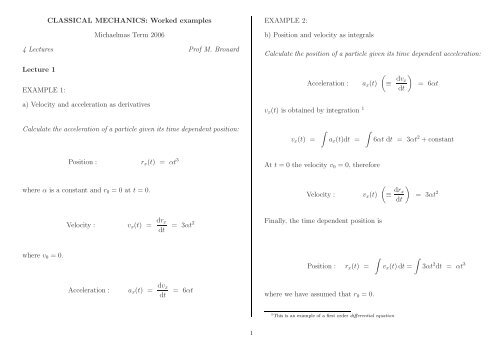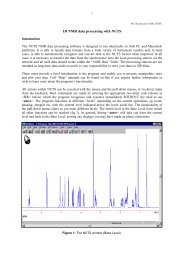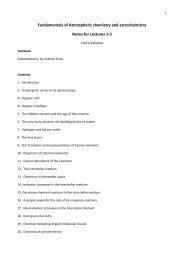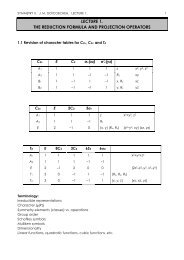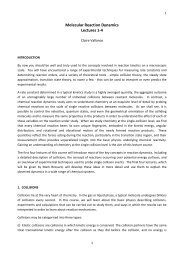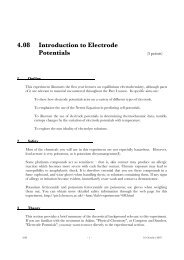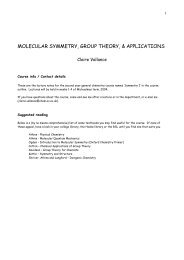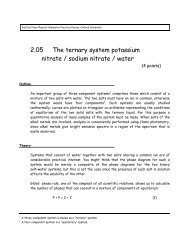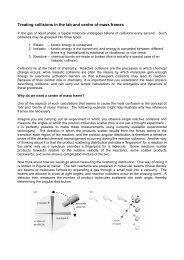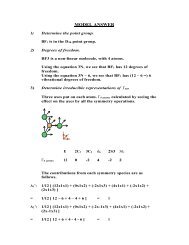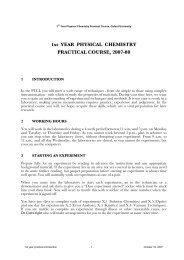CLASSICAL MECHANICS: Worked examples Michaelmas Term ...
CLASSICAL MECHANICS: Worked examples Michaelmas Term ...
CLASSICAL MECHANICS: Worked examples Michaelmas Term ...
Create successful ePaper yourself
Turn your PDF publications into a flip-book with our unique Google optimized e-Paper software.
<strong>CLASSICAL</strong> <strong>MECHANICS</strong>: <strong>Worked</strong> <strong>examples</strong><strong>Michaelmas</strong> <strong>Term</strong> 20064 Lectures Prof M. BrouardEXAMPLE 2:b) Position and velocity as integralsCalculate the position of a particle given its time dependent acceleration:Lecture 1EXAMPLE 1:Acceleration :a x (t)(≡ dv )xdt= 6αta) Velocity and acceleration as derivativesv x (t) is obtained by integration 1Calculate the acceleration of a particle given its time dependent position:v x (t) =∫a x (t)dt =∫6αt dt = 3αt 2 + constantPosition : r x (t) = αt 3At t = 0 the velocity v 0 = 0, thereforewhere α is a constant and r 0 = 0 at t = 0.Velocity :v x (t)(≡ dr )xdt= 3αt 2Velocity :v x (t) = dr xdt= 3αt 2Finally, the time dependent position iswhere v 0 = 0.Position : r x (t) =∫∫v x (t) dt =3αt 2 dt = αt 3Acceleration :a x (t) = dv xdt= 6αtwhere we have assumed that r 0 = 0.1 This is an example of a first order differential equation1
EXAMPLE 3:Electrons, initially travelling at 2.4 × 10 6 ms −1 in the horizontal direction,enter a region between two horizontal charged plates of length 2cmwhere they experience an acceleration of 4 × 10 14 ms −2 , vertically upwards.Find (a) the vertical position as they leave the region between the plates,and (b) the angle at which they emerge from between the plates.For motion along the x coordinatea x = 0v x = v 0x = 2.4 × 10 6 m s −1r x = r 0x + v 0x t r 0x = 0r x= 0.02 m = 2.4 × 10 6 tt = 8.33 × 10 −9 sand along the y coordinatea yEXAMPLE 4:Acceleration:v 0,xy+xe - -∫Therefore= 4 × 10 14 m s −2v y = v 0y + a y t v 0y = 0r y = r 0y + 1a 2 yt 2 r 0y = 0Substituting for the time the electron spends between the platesr y = 1 2 a yt 2 = 0.0139 mFor the angle at which the electrons departtan θ = v yv x= a ytAn object of mass m, dropped from height h, experiences a retardingforce due to air resistance of kv, where k is a constant.Assuming that gravity exerts a constant acceleration, g, what is the terminalvelocity of the object, v T ?a ≡ dvdt= g − k m vThis differential equation can be solved by separating the variables, vand t, and integrating:Fair = -kv∫dvg − k v = dt + constantm− m k ln (g − k m v )= t + constantln(g − k )m v = − k m t + constant′When t = 0, v = 0As t → ∞, v → v Tln g = constant ′v = mgk(1 − e − k m t )v T = mgkHow does the height of the particle vary with time?vv T0mgt2
EXAMPLE 7:Two protons (H + ), initially separated at large r and possessing initialvelocities v = 200ms −1 , collide head-on. What is their separation ofclosest approach?V( r)H + H +v-vr 0V=E=K irAssume that initially all the energy is kinetic energy, E = K i , (since theprotons are separated to large r initially). Because both protons havethe same mass and speed we may writeK i = E = 1 2 mv2 1 + 1 2 mv2 2 = mv 2As the particles approach, the potential energy increases according tothe equationV (r) =q24πǫ 0 rand the kinetic energy decreases by the same amount (conservation ofenergy). At the separation of closest approach, r 0 , both particles aremomentarily stationary and thusE = V (r 0 ) = mv 2r 0 =q 24πǫ 0 mv 2 4
Lecture 3EXAMPLE 8:Someone stands on a platform, which rotates at 0.5 revolutionss −1 . Witharms outstretched, they hold two 4 kg blocks at a distance of 1 m fromthe axis of rotation, which passes through the centre of the person. Theythen reduce the distance of the blocks to 0.5 m.Assuming that the moment of inertia of the person and the platform(excluding the blocks) is constant at 4 kgm 2 , (a) what is the new angularvelocity and (b) what is the change in kinetic energy?EXAMPLE 9:A person stands on a stationary (but rotatable) platform with a spinningbicycle wheel in their hands. The moment of inertia of the person andthe platform is I w = 4 kgm 2 , and for the bicycle wheel it is I b = 1 kgm 2 .The angular velocity is 10 rads −1 counterclockwise as viewed from above.Explain what happens when the person turns the wheel upside down (assumingthere are no external torques acting on the system).Define the z-axis pointing vertically upwards. The initial angular momentumis therefore(a) The moment of inertia of the system is initiallyI i = 4 + 2mr 2 i = 12 kg m 2and finallyI f = 4 + 2mr 2 f = 6 kg m 2The initial angular frequency is ω i = 2πf i = π rads −1and thus, applying angular momentum conservation,l i = +I b ω bwhere the plus is defined by the right hand rule.In the absence of external torquesl f = l il iI i ω i = I f ω fω f = 2π rad s −1(b) The initial and final kinetic energies are given byandK i = 1 2 I iω 2 i = 6π 2 JK f = 1 2 I fω 2 f = 12π 2 JThus the change in kinetic energy is∆K = K f − K i = 6π 2 ≃ 60 JNote that the increase in kinetic energy is supplied by the man doingwork in pulling the blocks inwards.Since the final angular momentum of the bicycle is −I b ω b the platformmust rotate to conserve angular momentum.l f = I w ω w − I b ω bEquating the initial and final momenta one findsω w = + 2I b ω b /I w = + 5 rad s −1 l fl wl bwhere the + sign indicates that the platform plus the person rotate inthe counterclockwise direction (the + z direction).5
EXAMPLE 10:A rocket of mass m is fired at 60 o to the local vertical with an initialspeed v 0 = √ GM/R where M and R are the mass and radius of theearth respectively. Show that its maximum distance from the earth’scentre is 3R/2.The solution uses both conservation of energy and angular momentum.Initially, the angular momentum isl ≃ mv 0 sin 60R = m √ GMR sin 60and the kinetic energy isK = 1 2 mv2 0 = GmM/2RThe total energy is thereforeE = K+V = K−GmM/R = −GmM/2RAt the maximum height, r, the rocket is no longer moving radially outwards.However, to conserve angular momentum, it must still haveangular kinetic energy given byK ang = l 2 /2I = 3mGMR/8r 2Thus the total energy at the maximum height isE = V + K ang = −GmM/r + 3GmMR/8r 2Equating the two expressions for the total energyyieldsr =− 12R = −1 r + 3R8r 24r 2 − 8Rr + 3R 2 = 08R ± 4R8The latter solution is unphysical!v 060 o vr= 3 2 R or 1 2 R6
Lecture 4EXAMPLE 11:A mass of 100g hangs at the end of a spring (which obeys Hooke’s Law).When the mass is increased by another 100g the spring extends a further8cm. What is the spring constant? (Assume that the acceleration dueto gravity is 9.8ms −2 .)x=0.08mx=0.05m(i) From the definition of the frequency of a harmonic oscillator√ √k 12.25ω =µ = = 7.8 rad s−10.2f = 1 ω = 1.25 Hz2πBecause the mass is at equilibrium in both cases the net force on themass is zero, and we can write(ii) The velocity of the harmonic oscillator (the time derivative of theposition) isWith extra mass addedF = 0i.e. kx = mgv(t) = Aω cos (ωt + φ)with A = 0.05m. This is a maximum (minimum) when cos(z) = ±1,i.e. when z = 0, π,F = 0kx ′ = k(x + 0.08) = 2mgSubtracting the two expressions obtained before and after addition ofthe extra mass givesk = mg∆x= 12.25 Nm−1If the masses are pulled down a further 5cm and then released, whatwould be (i) the frequency of vibration, (ii) the maximum velocity of themasses, and (iii) the maximum acceleration of the resulting motion.v max = ±0.05 ω = ±0.39 m s −1Note that the position (displacement from equilibrium) is zero at thistime.(iii) Similarly, the maximum acceleration isa max = −Aω 2 = ∓3.0 m s −2which is obtained by taking the maximum in the time derivative of thevelocity.7
EXAMPLE 12:Show that the functionx = αe iωt + βe −iωt (1)is a solution of the differential equation describing a harmonic oscillatorof frequency ω:d 2 xdt 2 = −ω2 xComment on the relationship between the above equation for x and thesolution x = A sin (ωt + φ).Taking the first and second time derivative of x one obtainsThe latter can be writtenẋ = iω(αe iωt − βe −iωt )ẍ = i 2 ω 2 (αe iωt + βe −iωt )ẍ = −ω 2 xand therefore equation (1) clearly satisfies the differential equation (it isactually the general solution).The link with the more familiar solution x = A sin (ωt + φ) can be establishedusing the fact thate ±iωt = cos ωt ± i sin ωtSubstitution of this equation in the top expression for x yieldsx = C cosωt + D sin ωt (2)with C = α+β and D = i(α−β). However, using standard trigonometryx = A sin (ωt + φ) can be rewrittenx = A (sin ωtcos φ + cos ωtsin φ)which is the same as equation (2) with C = A cosφ and D = A sin φ.8


